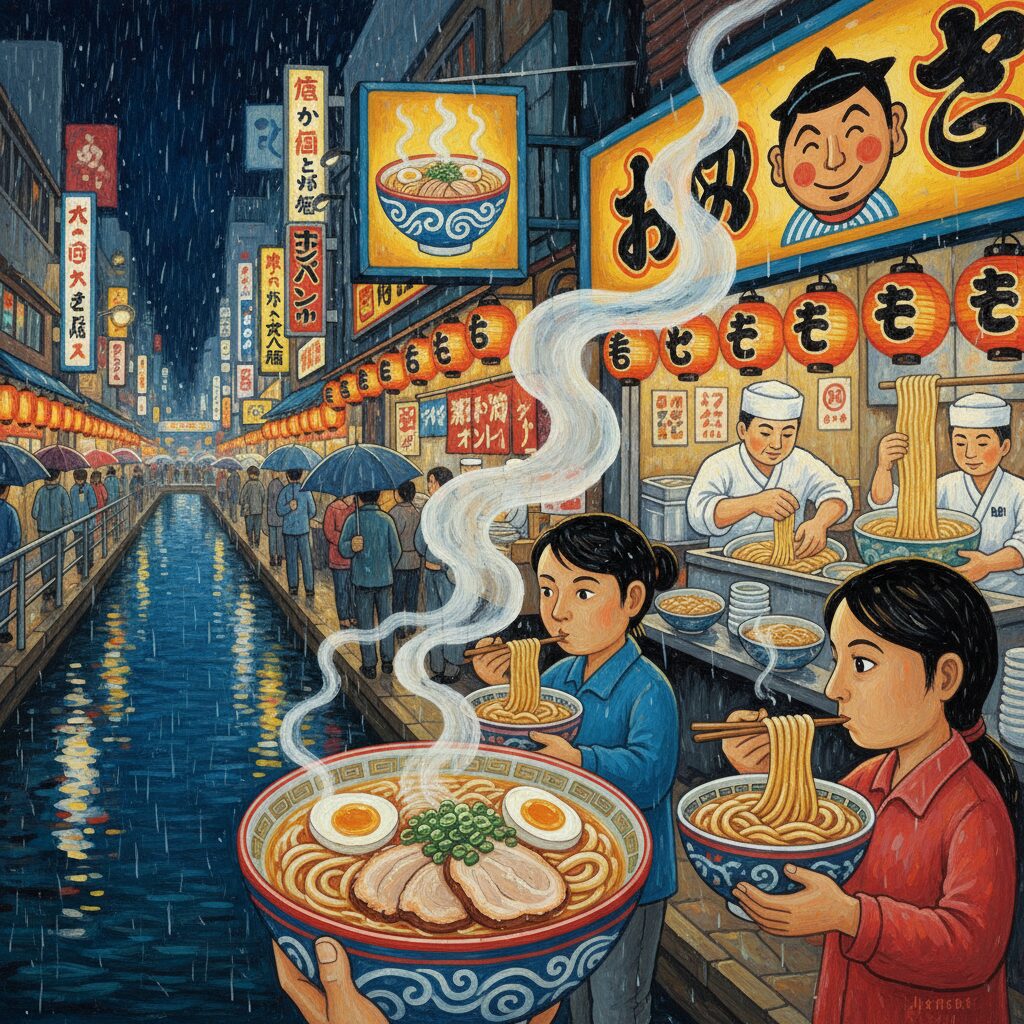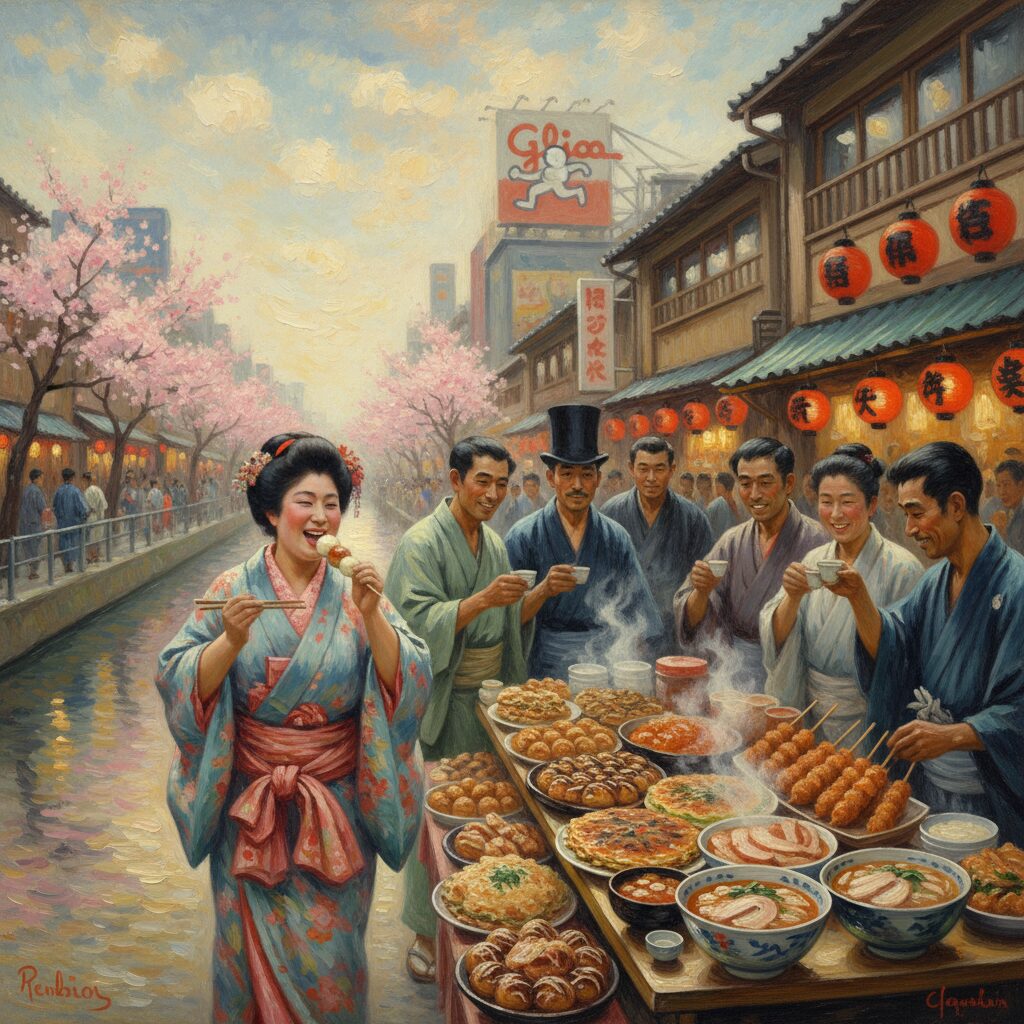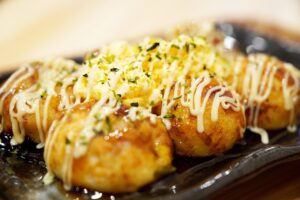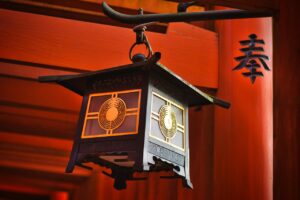Welcome to Osaka, a city where the soul sings a melody of sizzling griddles and bubbling broths. At the very heart of this culinary symphony is Dotonbori, a dazzling, electrifying canal-side district that serves as the city’s unofficial kitchen. This isn’t just a place to eat; it’s a living, breathing testament to a culture famously defined by the term kuidaore, which translates to the glorious philosophy of eating until you drop, both financially and physically. As the sun dips below the horizon, Dotonbori awakens, transforming into a kaleidoscope of neon brilliance. Giant, animated signs—a colossal crab with waving claws, a mythical dragon guarding a ramen shop, and the iconic Glico Running Man frozen mid-stride in victory—paint the night sky, reflecting off the dark, shimmering waters of the Dotonbori Canal. The air itself is a rich tapestry of scents: the savory perfume of grilled octopus, the sweet allure of freshly baked pastries, and the deep, umami-rich aroma of soy and dashi. The sound is a constant, joyful hum of vendors calling out, crowds chattering in a dozen languages, and the rhythmic sizzle of food meeting hot steel. This is not a journey for the faint of heart or the small of appetite. This is a pilgrimage for the foodie, a walking tour through a wonderland of flavors where every stall and restaurant tells a story of tradition, innovation, and an unwavering passion for incredible food. Prepare your senses, bring your appetite, and let’s dive headfirst into the delicious chaos of Dotonbori.
While you’re exploring the vibrant food scene of Dotonbori, you might also want to discover the unique street culture of Amerikamura just a short walk away.
The Savory Soul of Osaka: Takoyaki and Okonomiyaki

Your Dotonbori journey should start with the city’s most famous street food: takoyaki. These charming, golf-ball-sized rounds of grilled batter are more than just a snack—they are a symbol of Osakan pride. You’ll easily recognize the takoyaki stands by their long lines and the captivating sight of chefs at work. They stand before cast-iron pans dotted with hemispherical molds, skillfully pouring a savory, dashi-infused batter. A tender piece of octopus, or tako, is placed in the center of each ball, followed by bits of pickled red ginger (beni shoga), tempura scraps (tenkasu), and green onion. The true artistry begins here. Using only a pair of long, sharp picks, the chefs skillfully and rhythmically turn the partially cooked balls, twisting and flipping them rapidly until they become perfect, golden-brown spheres. Watching this process is like a form of street theater—a dance of precision and heat.
The instant a boat-shaped tray of freshly made takoyaki is handed to you, the sensory experience heightens. Steam rises from the piping-hot balls, carrying their delectable aroma. They are traditionally coated with a thick, sweet-savory brown takoyaki sauce, drizzled with creamy Japanese mayonnaise, and topped with a flurry of delicate, paper-thin bonito flakes (katsuobushi) that appear to dance and writhe in the heat. A final sprinkle of powdered green seaweed (aonori) adds a hint of oceanic flavor. The first bite is a revelation, yet also a test of patience—as they are notoriously mouth-scorchingly hot. Once you manage the temperature, you’re rewarded with a textural masterpiece: a slightly crisp outer shell yielding to a molten, creamy interior, with the firm, satisfying chew of octopus at its core. It’s a complex burst of flavors—sweet, savory, tangy, and rich with umami—that perfectly embodies the bold, generous spirit of Osaka.
Just a few steps away lies the realm of takoyaki’s heartier cousin, okonomiyaki. Often described as a “savory Japanese pancake,” this phrase barely captures its essence. The name itself, derived from okonomi (how you like) and yaki (grilled), hints at its customizable and personal nature. The base is a batter mixed with a mountain of shredded cabbage and often egg, lending it surprising lightness. From there, the choice is yours: thin slices of pork belly, squid, shrimp, or a combination of all. In many Dotonbori restaurants, you can watch the chef prepare it on a huge teppan (iron griddle) built into the counter or even your table. The batter is ladled out, shaped into a thick circle, and cooked slowly until the cabbage softens and the exterior turns a beautiful golden brown. The sizzling sound and rising steam add to the anticipation. Once done, it’s topped with the same holy trinity of toppings as takoyaki: rich, dark okonomiyaki sauce, a lattice of Japanese mayonnaise, dancing bonito flakes, and a sprinkle of aonori. Unlike bite-sized takoyaki, okonomiyaki is a full, comforting meal. Each mouthful is a warm, savory hug, with the sweetness of the cabbage contrasting the richness of the sauce and the smoky flavor of grilled pork or seafood. It’s a dish that feels both rustic and deeply satisfying—a true reflection of Osaka’s unpretentious, soul-warming cuisine.
Skewers and Bites: Kushikatsu and Gyoza on the Go
As you wander deeper into the neon-lit alleys branching off the main canal walk, a new scent fills the air: the clean, enticing aroma of hot oil and fried delights. This is the realm of kushikatsu, one of Osaka’s famed culinary treasures. These are deep-fried skewers featuring virtually anything you can imagine. The tradition began in the nearby Shinsekai district but has since become a beloved staple of Dotonbori’s food scene. Glass-fronted displays reveal a dazzling variety of pre-skewered ingredients: chunks of beef, pork loin, chicken, and shrimp; vegetables like onion, lotus root, shiitake mushrooms, and asparagus; and even more adventurous choices such as quail eggs and cheese. Each skewer is dipped in a light batter, coated with fine panko breadcrumbs, and then immersed in hot, clean oil until it emerges golden and irresistibly crisp.
The kushikatsu experience comes with one golden, unbreakable rule—a sacred piece of local etiquette. The skewers are served with a communal pot of thin, dark dipping sauce. You are allowed to dip your skewer only once before taking your first bite. Every shop clearly displays the sign: Nidozuke kinshi—no double-dipping! This rule exists for hygiene reasons, and breaking it is considered the ultimate culinary faux pas. If you need more sauce mid-skewer, you use a provided slice of raw cabbage to scoop and drizzle it on. This cabbage also acts as a wonderfully refreshing palate cleanser between the rich, fried bites. The magic of kushikatsu lies in its simplicity and the pure joy of its texture. The panko crust shatters with a satisfying crunch, unveiling a perfectly cooked, tender interior. Paired with a cold Japanese beer, it’s the ultimate casual dining experience—perfect for sharing with friends while soaking in the lively atmosphere of the area.
Alongside the kushikatsu kingdom, you will find stalls offering another ideal handheld treat: gyoza. While these pan-fried dumplings are popular throughout Japan, Osaka’s Dotonbori brings a particular flair to them. The aroma of garlic, ginger, and sizzling pork is an irresistible draw. The best gyoza stalls cook their dumplings on a massive circular griddle, where they are first steamed then fried, creating a delightful contrast. The tops remain soft and tender, while the bottoms turn a lacy, golden-brown crisp known as hane (wings). The filling is a juicy, savory mix of ground pork, cabbage, chives, and seasonings. They are typically served lined up, often still connected by the crispy hane, alongside a dipping sauce of soy sauce, rice vinegar, and a dollop of chili oil (rayu) for a spicy kick. Taking a whole gyoza in one bite releases a burst of savory, umami-rich juices. It’s a simple food crafted with exceptional skill, and its portable nature makes it the perfect snack to keep you energized as you continue exploring Dotonbori’s endless delights.
Noodle Nirvana: Ramen and Udon Along the Canal

No food tour of Japan is truly complete without exploring its rich noodle culture, and Dotonbori boasts some of the finest bowls in the country. As night falls, the desire for something warm, soupy, and deeply comforting often arises. This is when ramen shops, with their steaming windows and striking signage, become beacons for the hungry traveler. Dotonbori hosts some of Osaka’s most renowned ramen establishments, easily identified by their dramatic storefronts. Kinryu Ramen, for instance, is guarded by a colossal three-dimensional dragon, while Ichiran provides a unique solo dining experience in private booths, designed to help you focus solely on the bowl before you. The ramen here is typically tonkotsu style, featuring a rich, opaque broth made by simmering pork bones for hours until it turns creamy and packed with collagen. This luscious broth clings to every strand of firm, springy noodles. A classic bowl is adorned with tender slices of chashu (braised pork belly), a perfectly soft-boiled egg with a jammy yolk (ajitama), crisp bamboo shoots (menma), and a sprinkle of fresh green onions. Ordering is often done via a ticket machine at the entrance, a distinctly Japanese custom: you insert your cash, select your desired ramen and any extra toppings, and hand the ticket to the chef. Within minutes, a steaming, fragrant bowl of noodle perfection arrives. Slurping your noodles is not only acceptable but encouraged; it cools them down and enhances the flavor. A bowl of Dotonbori ramen is more than just a meal; it’s a restorative, soul-soothing ritual.
For those looking for a subtler yet equally delicious noodle experience, Dotonbori offers a taste of local history with kitsune udon. This dish is believed to have originated right here in Osaka, making it a must-try for anyone eager to connect with the city’s culinary heritage. Unlike the intense richness of tonkotsu ramen, kitsune udon showcases the elegant simplicity of Japanese cuisine. The star is the broth, a clear, golden dashi made from kelp (kombu) and bonito flakes, seasoned with light soy sauce, mirin, and sake. It’s a delicate, clean-tasting broth with a profound umami depth. Immersed in this gentle soup are thick, chewy, and wonderfully soft udon noodles. The dish is named after its signature topping: a large piece of sweet, fried tofu pouch called aburaage. According to Japanese folklore, foxes (kitsune) are said to love fried tofu, and the aburaage’s color resembles a crouching fox. The tofu is simmered in a sweet and savory liquid until plump and juicy, absorbing all the flavors. When bitten into, it releases a burst of sweetness that perfectly complements the savory dashi. Kitsune udon is the ultimate comfort food—warm, gentle, and deeply satisfying. It offers a perfect contrast to the bold and powerful flavors you’ll find on your Dotonbori adventure.
Sweet Endings and Unique Treats: Melonpan and More
After savoring a parade of delicious savory dishes, your palate will undoubtedly crave a sweet finale. Dotonbori’s dessert scene is just as lively and captivating as its savory fare, presenting a delightful blend of traditional Japanese confections and trendy, Instagram-worthy creations. One of the most popular treats you’ll encounter is the Melonpan Ice Cream Sandwich. Don’t be misled by the name; traditional melonpan contains no melon. It’s a soft, enriched sweet bun topped with a thin layer of crisp cookie dough, often featuring a cross-hatch pattern reminiscent of cantaloupe melon. The street vendors in Dotonbori have elevated this simple pastry to new heights by taking a freshly baked, warm, and fragrant melonpan, slicing it in half like a hamburger bun, and filling it with a generous scoop of ice cream. Classic vanilla is a favorite, but matcha, chocolate, or seasonal fruit flavors are frequently available. The experience offers a delightful contrast of temperatures and textures: the warm, fluffy bread, the crunchy, sugary crust, and the cold, creamy ice cream melting into every nook. It’s a decadent, messy, and utterly unforgettable treat.
For a more traditional Japanese sweet, be sure to look for stalls selling taiyaki. These charming fish-shaped cakes have been a beloved treat for generations. The batter, similar to pancake or waffle mix, is poured into a fish-shaped mold. A spoonful of classic sweet red bean paste (anko) is added before closing the mold and cooking it over a flame until golden brown and slightly crispy on the outside. Biting into a fresh, hot taiyaki is pure delight. The cake is warm and tender, while the anko filling is earthy and sweet without overwhelming. Though red bean is the original, many shops now offer modern fillings like rich custard cream, chocolate, or even savory options such as cheese or sausage. The whimsical fish shape is believed to bring good luck, making it not only a delicious snack but also a charming cultural experience.
In recent years, another dessert sensation has taken Dotonbori by storm: the freshly baked cheese tart. Stores like Pablo, with its iconic branding and constant lines, have become destinations in their own right. The scent of baking cheese and butter drifts through the air, drawing crowds. These tarts are a marvel of pastry craftsmanship, featuring a buttery, flaky crust filled with a light, airy, and incredibly creamy cheese mousse. You can often select your preferred “doneness,” from “rare,” nearly liquid in the center, to “medium,” which is more firm. The top is brushed with a glossy apricot glaze that adds a beautiful shine and a touch of fruity tartness. Served warm, the filling oozes out at the first bite, delivering a burst of tangy, sweet, and rich cheese flavor that melts in your mouth. Whether you opt for a large tart to share or a mini one all to yourself, it’s a modern dessert phenomenon that has secured its place in Dotonbori’s culinary story.
Embracing the Spirit of Kuidaore

A walking tour of Dotonbori offers a deep dive into the very soul of Osaka. This area celebrates food not merely as nourishment, but as entertainment, community, and a pure expression of joy. To fully appreciate it, arrive with an open mind and an empty stomach. The best time to visit is in the evening, when thousands of neon lights illuminate the district, casting a magical glow over the crowds and the canal. While weekends are bustling with energy, weekday evenings tend to be less crowded, allowing for a more relaxed experience.
A few practical tips will help you navigate this delicious chaos. First, although it’s a street food paradise, eating while walking is generally considered rude in Japan. Most vendors provide a small space beside their stalls where you can stand and enjoy your food. Second, carry some cash, as many smaller, family-run stalls may not accept credit cards. Finally, plan ahead for your trash disposal. Public bins are rare, so be ready to hold onto wrappers and containers until you find one or can dispose of them at your hotel. Access is easy via Namba Station, which serves multiple subway lines and is just a short walk from the area.
Dotonbori is far more than just a cluster of restaurants and food stalls. It’s the vibrant heartbeat of Osaka, a place where you can sense the city’s history as an entertainment hub alongside its modern identity as a food-obsessed metropolis. It offers a sensory overload in the best way—a symphony of sights, sounds, and smells that linger long after your last bite. So, stroll along the canal, let the giant crab and the running man guide you, and embrace the spirit of kuidaore. Eat with passion, curiosity, and until you can eat no more. In Dotonbori, that’s not just encouraged; it’s a way of life.








